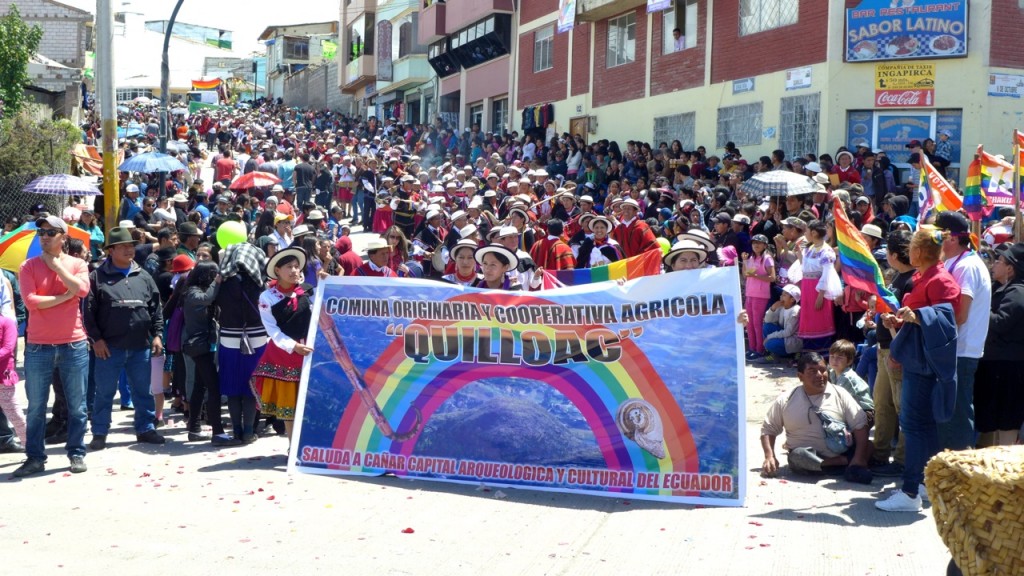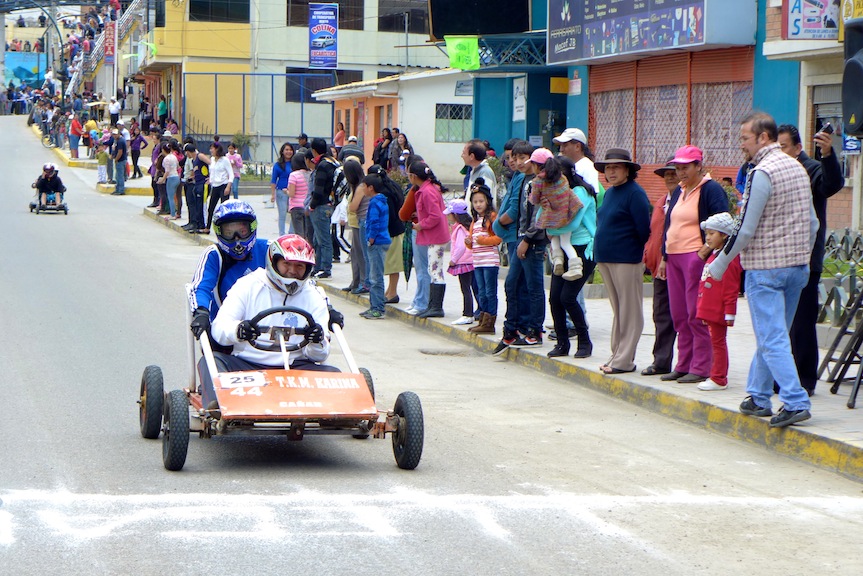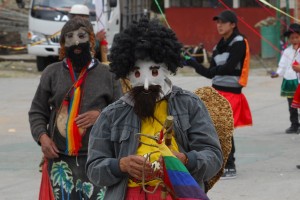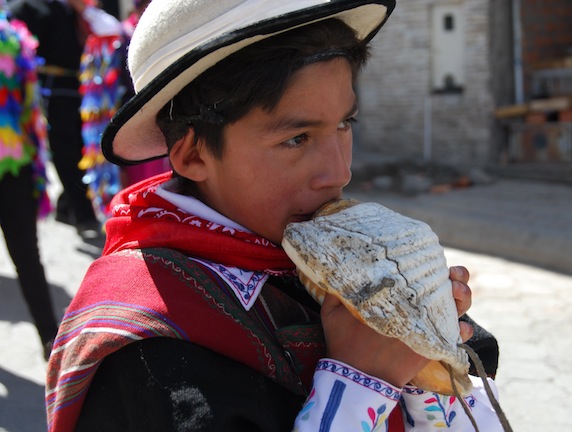January is always a busy time here, what with the five-day Fiesta de San Antonio de Padua, held this month despite the fact his official saint’s day is June 13, when he died in Padua, Italy, in 1231. Then there’s the Fiestas de Cañar, an annual civic celebration lasting fifteen days, beginning with a cleaning of the city streets, ending with fireworks, and in between a handcrafts fair, lectures, soccer games, concerts, dances, a bull fight, and an long-long parade on January 26 to celebrate Cañar as the self-proclaimed archeological capital of Ecuador. I gladly photograph it all, sometimes by invitation; and sometimes I get a call as the big parade is forming up: “Judicita, we’re hundreds of people from Quilloac getting ready to march. Come take some photos!”
I gladly photograph it all, sometimes by invitation; and sometimes I get a call as the big parade is forming up: “Judicita, we’re hundreds of people from Quilloac getting ready to march. Come take some photos!”
 Other times, I come upon things by accident, as today when I walked into town and stumbled on the finish line of the wooden car race, always held the last day of the civic fiesta, when hand-made wooden carts race down the Pan American from the high hill on the outskirts of town.
Other times, I come upon things by accident, as today when I walked into town and stumbled on the finish line of the wooden car race, always held the last day of the civic fiesta, when hand-made wooden carts race down the Pan American from the high hill on the outskirts of town.
But my favorite event is the Fiesta de San Antonio, held in the hamlet of Junducuchu high on the mountain, with its own saint – a tiny figure or “doll” found in a mountain crevice 100 years ago by a woman of the village, and venerated ever since. (Below: tiny San Antonio is behind glass…the figure alongside represents El Nîño, or baby Jesus.) 
The tiny San Antonio lives with a host family that changes year to year, a transition marked by carrying the saint into town to the church to be blessed before being carried back up the mountain in the arms of the wife or daughters of the prioste – the new guardian of the saint, who will also host the fiesta, including feeding hundreds of people several times in the course of five days.
On a bright Saturday morning I joined up outside the church, where the vacas locas gather and dance while waiting for the saints and village leaders to emerge from the blessing. Men and boys prance around as huge “crazy cow” puppets, mooing and snorting, or pretending to poke onlookers, as a town band plays. These wonderful vaca locas are hand-made of cow hide stretched over a wooden form, with papier mâché heads, decorated in inventive ways, and a wooden bar across the front for the dancers to hang onto and maneuver for the hours they must be carried.
.
 Meanwhile, other figures join in, and onlookers gather, waiting for the taytas or community leaders to emerge from the church
Meanwhile, other figures join in, and onlookers gather, waiting for the taytas or community leaders to emerge from the church

 After a short march around the town we start up the mountain, the band playing nonstop. Meanwhile, another group has left the village to come down to meet us. This procession includes boys and girls, dancers, a man carrying a maypole, a trio of flutes and drum, accompanied by various other characters, such as the rukuyayas, or clowns, who make mischief as long as the fiesta lasts:
After a short march around the town we start up the mountain, the band playing nonstop. Meanwhile, another group has left the village to come down to meet us. This procession includes boys and girls, dancers, a man carrying a maypole, a trio of flutes and drum, accompanied by various other characters, such as the rukuyayas, or clowns, who make mischief as long as the fiesta lasts:
And the bands:
And this wonderful old man, who appears every year in his mask and vaquero, or cowboy, gear, of rope and chaps. He dances for hours and hours, sleeps a bit sitting up, then dances some more. One year he grabbed onto me to dance, and insisting on calling me his warmi, “woman” in Quichua.
 Well, this is only one day of the fiesta and I’m usually worn out by the third day. All this January activity wraps up in time to prepare for Carnaval, the biggest Cañari fiesta of the year, celebrated the Monday before Lent. This year it is mercifully late, on March 5.
Well, this is only one day of the fiesta and I’m usually worn out by the third day. All this January activity wraps up in time to prepare for Carnaval, the biggest Cañari fiesta of the year, celebrated the Monday before Lent. This year it is mercifully late, on March 5.
We’ve had a month of brilliant weather – sunny and warm but so dry that the farmers around us badly need rain. They plow and plant in January anticipating the rainy season, which should have started before now.
One of the goings on I came across the other day was a minga, a cooperative work day that is part indigenous tradition, part hacienda custom, I suspect. Everyone in a comuna is called out to work, in this case on an irrigation project. The old way was to blow on a conch shell, called a quipo. Now they probably use cell phones.
Those who don’t work must pay a fine, or send a laborer for which they pay. I came across this scene the other day near our house – maybe two hundred people digging up old and broken concrete irrigation pipes, to be replaced with plastic ones. They live in a village far down the mountain, and no water has reached them during this drought. When I came by later in the day, the pipe was laid and the ditch covered. Irrigation is, and has always been, the life’s blood of agriculture, and of rural life. Next week there will be another minga near our house, and we were told we will be expected to colaborar – collaborate, meaning either work or make a contribution. Stay tuned!










Great photos, Judy. It’s a miracle any work gets done, what with all the fiestas! Where do the conch shells come from?
Great to read about a St Anthony of Padua celebration. I credit him with saving me from a particularly odious & persistent (rather frightening, actually) “stalker” when I was in Padua some years ago. This guy followed me in his car, managing to stay with me in spite of my various strategems, until I was finally able to race across seveal lanes of a traffic cirlcle/intersection and duck into St A’s big church. That both scared off my pursuer and provided me with a most interesting hour or two examining the evidence of St A’s (other) miracles.
I especially enjoyed this post. The photos and descriptions were great.
It’s really wonderful to see so much life and happiness in what I remember as a sad little town with a worried past. Congratulations to the canton’s fathers and mothers! I do wish I were there for at least a portion of the fiesta days.
Hey “Warmi” – as always…..great photos and great stories to match! Wishing your area some rain.
Great to read about Canari festivities; they are quite different from the parades, etc. that I have experienced in Cuenca. Perhaps I can visit you sometime soon in your area.
I live in the city of San Antonio de Padua here, in Buenos Aires, Argentina… Regards and thank you very much for allowing me to travel with you through your photos and stories. Greetings to Michael!
Judy, Thank you for sharing your experiences with us. The photos and commentary are wonderful. We are so lucky to have you as our eyes and ears. All the best.